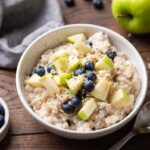Grain-free dog food has surged in popularity, but what’s driving this trend? Is it simply a marketing tactic, or are there genuine health benefits for our canine companions? This article delves into the reasons behind the rise of grain-free diets, examining the science, potential benefits, and controversies surrounding this increasingly common pet food choice.
In recent years, many pet owners have turned to grain-free dog food, driven by concerns about allergies, digestion, and overall health. But what does “grain-free” really mean, and is it the right choice for your dog? To understand the craze, let’s unpack the arguments for and against grain-free diets, and consider the scientific evidence available.
Understanding Grain-Free Dog Food
Grain-free dog food, as the name suggests, excludes common cereal grains like wheat, corn, and soy. Instead, these formulas often rely on alternative carbohydrate sources such as peas, lentils, potatoes, and sweet potatoes. The rationale behind this shift stems from the belief that grains are unnecessary fillers that can trigger allergies or digestive issues in some dogs.
The Allergic Reaction Myth and Ingredient Sensitivities
One of the primary drivers behind the grain-free movement is the perception that grains are common allergens for dogs. However, studies show that food allergies in dogs are more commonly attributed to protein sources, such as beef, chicken, and dairy. While grain allergies do exist, they are statistically less frequent than protein-related allergies.
That being said, it’s important to recognize that all dogs are different. Some dogs have sensitivities to ingredients such as grains and thrive on grain-free diets.
Potential Benefits of Grain-Free Diets
While scientific evidence supporting the broad superiority of grain-free diets is limited, some potential benefits can be observed in specific cases:
- Improved Digestion: Some dogs may find grain-free formulas easier to digest, leading to reduced gastrointestinal upset.
- Shinier Coat and Healthier Skin: Certain dogs may experience improvements in coat quality and skin health when switched to a grain-free diet, particularly if they have mild sensitivities to certain grains.
- Weight Management: The higher protein and fat content in some grain-free foods may help promote satiety and support healthy weight management.
It’s crucial to remember that these benefits are not universally guaranteed and can vary depending on the individual dog’s needs and sensitivities.
The DCM Controversy: A Cause for Concern?
In recent years, the Food and Drug Administration (FDA) investigated a potential link between grain-free diets and dilated cardiomyopathy (DCM), a heart condition in dogs. The investigation focused on diets containing high proportions of peas, lentils, and/or potatoes. While the FDA hasn’t definitively established a causal relationship, the findings raised concerns about the potential risks associated with certain grain-free formulations. It’s important to note that the FDA continues to encourage research and collaboration by academia, veterinarians, and industry.
The FDA’s Center for Veterinary Medicine (CVM) and the Veterinary Laboratory Investigation and Response Network (Vet-LIRN), a collaboration of government and veterinary diagnostic laboratories, continue to investigate this potential association. Based on the data collected and analyzed thus far, the agency believes that the potential association between diet and DCM in dogs is a complex scientific issue that may involve multiple factors.
Grains Aren’t Necessarily Bad
It’s important to dispel the misconception that all grains are inherently harmful to dogs. Many grains, such as brown rice and oats, can be nutritious sources of fiber, vitamins, and minerals. These grains can contribute to a well-balanced diet for many dogs.
Choosing the Right Diet for Your Dog
The best approach to feeding your dog is to work closely with your veterinarian. They can assess your dog’s individual needs, health status, and potential sensitivities to recommend the most appropriate diet. When discussing diet options, consider the following:
- Ingredients: Carefully examine the ingredient list, paying attention to the quality and source of protein, carbohydrates, and fats.
- Nutritional Adequacy: Ensure that the food meets the Association of American Feed Control Officials (AAFCO) nutritional guidelines for your dog’s life stage.
- Individual Needs: Consider your dog’s age, breed, activity level, and any existing health conditions.
The Bottom Line: Informed Choices and Veterinary Guidance
While grain-free dog food can be a suitable option for some dogs, it’s essential to approach this dietary choice with caution and consult with your veterinarian. Avoid making assumptions based on marketing claims and instead focus on scientific evidence and your dog’s individual needs. By working with a veterinary professional, you can make informed decisions that support your dog’s long-term health and well-being.

